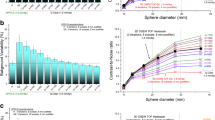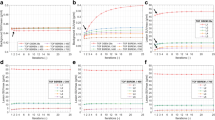Abstract
Purpose
There are several important positron emission tomography (PET) imaging scenarios that require imaging with very low photon statistics, for which both quantitative accuracy and visual quality should not be neglected. For example, PET imaging with the low photon statistics is closely related to active efforts to significantly reduce radiation exposure from radiopharmaceuticals. We investigated two examples of low-count PET imaging: (a) imaging [90Y]microsphere radioembolization that suffers the very small positron emission fraction of Y-90’s decay processes, and (b) cancer imaging with [68Ga]citrate with uptake time of 3–4 half-lives, necessary for visualizing tumors. In particular, we investigated a type of penalized likelihood reconstruction algorithm, block sequential regularized expectation maximization (BSREM), for improving both image quality and quantitative accuracy of these low-count PET imaging cases.
Procedures
The NEMA/IEC Body phantom filled with aqueous solution of Y-90 or Ga-68 was scanned to mimic the low-count scenarios of corresponding patient data acquisitions on a time-of-flight (TOF) PET/magnetic resonance imaging system. Contrast recovery, background variation, and signal-to-noise ratio were evaluated in different sets of count densities using both conventional TOF ordered subset expectation (TOF-OSEM) and TOF-BSREM algorithms. The regularization parameter, beta, in BSREM that controls the tradeoff between image noise and resolution was evaluated to find a value for improved confidence in image interpretation. Visual quality assessment of the images obtained from patients administered with [68Ga]citrate (n = 6) was performed. We also made preliminary visual image quality assessment for one patient with [90Y]microspheres. In Y-90 imaging, the effect of 511-keV energy window selection for minimizing the number of random events was also evaluated.
Results
Quantitatively, phantom images reconstructed with TOF-BSREM showed improved contrast recovery, background variation, and signal-to-noise ratio values over images reconstructed with TOF-OSEM. Both phantom and patient studies of delayed imaging of [68Ga]citrate show that TOF-BSREM with beta = 500 gives the best tradeoff between image noise and image resolution based on visual assessment by the readers. The NEMA-IQ phantom study with [90Y]microspheres shows that the narrow energy window (460–562 keV) recovers activity concentrations in small spheres better than the regular energy window (425–650 keV) with the beta value of 2000 using the TOF-BSREM algorithm. For the images obtained from patients with [68Ga]citrate using TOF-BSREM with beta = 500, the visual analogue scale (VAS) was improved by 17 % and the Likert score was increased by 1 point on average, both in comparison to corresponding scores for images reconstructed using TOF-OSEM.
Conclusion
Our investigation shows that the TOF-BSREM algorithm improves the image quality and quantitative accuracy in low-count PET imaging scenarios. However, the beta value in this algorithm needed to be adjusted for each radiopharmaceutical and counting statistics at the time of scans.






Similar content being viewed by others
References
Walker MD, Asselin MC, Julyan PJ, Feldmann M, Talbot PS, Jones T, Matthews JC (2011) Bias in iterative reconstruction of low-statistics PET data: benefits of a resolution model. Phys Med Biol 56:931–949
Seith F, Schmidt H, Kunz J, Küstner T, Gatidis S, Nikolaou K, la Fougère C, Schwenzer N (2017) Simulation of tracer dose reduction in (18)F-FDG PET/MRI: effects on oncologic reading, image quality, and artifacts. J Nucl Med 58:1699–1705
Kadrmas DJ, Oktay MB, Casey ME, Hamill JJ (2012) Effect of scan time on oncologic lesion detection in whole-body PET. IEEE Trans Nucl Sci 59:1940–1947
Behr SC, Bahroos E, Hawkins RA, Nardo L, Ravanfar V, Capbarat EV, Seo Y (2018) Quantitative and visual assessments toward potential sub-mSv or ultrafast FDG PET using high-sensitivity TOF PET in PET/MRI. Mol Imaging Biol 20:492–500
Lima GM, Diodato S, Costabile E, Cicoria G, Civollani S, Marchetti C, Guidalotti PL, Pettinato C, Nanni C, Fanti S (2018) Low dose radiation 18F-fluoride PET/CT in the assessment of unilateral condylar hyperplasia of the mandible: preliminary results of a single centre experience. Eur J Hybrid Imaging 2:7
Ohnona J, Michaud L, Balogova S, Paycha F, Nataf V, Chauchat P, Talbot JN, Kerrou K (2013) Can we achieve a radionuclide radiation dose equal to or less than that of 99mTc-hydroxymethane diphosphonate bone scintigraphy with a low-dose 18F-sodium fluoride time-of-flight PET of diagnostic quality. Nucl Med Commun 34:417–425
Willowson KP, Bailey EA, Bailey DL (2012) A retrospective evaluation of radiation dose associated with low dose FDG protocols in whole-body PET/CT. Australas Phys Eng Sci Med 35:49–53
Zeimpekis KG, Barbosa F, Hullner M et al (2015) Clinical evaluation of PET image quality as a function of acquisition time in a new TOF-PET/MRI compared to TOF-PET/CT—initial results. Mol Imaging Biol 17:735–744
Murray I, Kalemis A, Glennon J, Hasan S, Quraishi S, Beyer T, Avril N (2010) Time-of-flight PET/CT using low-activity protocols: potential implications for cancer therapy monitoring. Eur J Nucl Med Mol Imaging 37:1643–1653
Alessio AM, Sammer M, Phillips GS, Manchanda V, Mohr BC, Parisi MT (2011) Evaluation of optimal acquisition duration or injected activity for pediatric 18F-FDG PET/CT. J Nucl Med 52:1028–1034
Wampl S, Rausch I, Traub-Weidinger T et al (2017) Quantification accuracy of neuro-oncology PET data as a function of emission scan duration in PET/MR compared to PET/CT. Eur J Radiol 95:257–264
Derlin T, Schmuck S, Klot C et al (2017) Evaluation of 68Ga-PSMA I&T PET/CT in 240 patients with biochemical relapse after primary therapy for prostate cancer : intraindividual comparison between standard and delayed imaging. J Nucl Med 58
Aggarwal R, Behr SC, Paris PL, Truillet C, Parker MFL, Huynh LT, Wei J, Hann B, Youngren J, Huang J, Premasekharan G, Ranatunga N, Chang E, Gao KT, Ryan CJ, Small EJ, Evans MJ (2017) Real-time transferrin-based PET detects MYC-positive prostate cancer. Mol Cancer Res 15:1221–1229
Behr SC, Aggarwal R, Seo Y, Aparici CM, Chang E, Gao KT, Tao DH, Small EJ, Evans MJ (2016) A feasibility study showing [(68)Ga]citrate PET detects prostate cancer. Mol Imaging Biol 18:946–951
Mari Aparici C, Behr SC, Seo Y et al (2017) Imaging hepatocellular carcinoma with 68Ga-citrate PET: first clinical experience. Mol Imaging 16:1536012117723256
Liow JS, Strother SC (1991) Practical tradeoffs between noise, quantitation, and number of iterations for maximum likelihood-based reconstructions. IEEE Trans Med Imaging 10:563–571
Qi J, Leahy RM (2006) Iterative reconstruction techniques in emission computed tomography. Phys Med Biol 51:R541–R578
Sah BR, Stolzmann P, Delso G, Wollenweber SD, Hüllner M, Hakami YA, Queiroz MA, Barbosa FG, von Schulthess GK, Pietsch C, Veit-Haibach P (2017) Clinical evaluation of a block sequential regularized expectation maximization reconstruction algorithm in 18F-FDG PET/CT studies. Nucl Med Commun 38:57–66
Ahn S, Ross SG, Asma E, Miao J, Jin X, Cheng L, Wollenweber SD, Manjeshwar RM (2015) Quantitative comparison of OSEM and penalized likelihood image reconstruction using relative difference penalties for clinical PET. Phys Med Biol 60:5733–5751
Wangerin KA, Ahn S, Ross SG et al (2015) Improving lesion detectability in PET imaging with a penalized likelihood reconstruction algorithm. Medical Imaging 2015: Image Perception, Observer Performance, and Technology Assessment, p 9416. https://doi.org/10.1117/12.2082301
Behr SC, Mollard BJ, Yang J, Flavell RR, Hawkins RA, Seo Y (2017) Effect of time-of-flight and regularized reconstructions on quantitative measurements and qualitative assessments in newly diagnosed prostate cancer with F-18-fluorocholine dual time point PET/MRI. Mol Imaging 16:153601211773670. https://doi.org/10.1177/1536012117736703
Ma H, Asma E, Ahn S et al (2013) Clinical evaluation of penalized likelihood reconstruction in whole-body PET studies. Eur J Nucl Med Mol Imaging 40:S109–S109
Ter Voert E, Muehlematter UJ, Delso G et al (2018) Quantitative performance and optimal regularization parameter in block sequential regularized expectation maximization reconstructions in clinical 68Ga-PSMA PET/MR. EJNMMI Res 8:70
Ahn S, Fessler JA (2003) Globally convergent image reconstruction for emission tomography using relaxed ordered subsets algorithms. IEEE Trans Med Imaging 22:613–626
Teoh EJ, McGowan DR, Macpherson RE et al (2015) Phantom and clinical evaluation of the Bayesian penalized likelihood reconstruction algorithm Q.Clear on an LYSO PET/CT system. J Nucl Med 56:1447–1452
Nuyts J, Beque D, Dupont P, Mortelmans L (2002) A concave prior penalizing relative differences for maximum-a-posteriori reconstruction in emission tomography. IEEE Trans Nucl Sci 49:56–60
Asma E, Ahn S, Ross SG et al (2012) Accurate and consistent lesion quantitation with clinically acceptable penalized likelihood images. 2012 Ieee Nuclear Science Symposium and Medical Imaging Conference Record (Nss/Mic). pp 4062–4066
Rowley LM, Bradley KM, Boardman P, Hallam A, McGowan DR (2017) Optimization of image reconstruction for (90)Y selective internal radiotherapy on a lutetium yttrium orthosilicate PET/CT system using a Bayesian penalized likelihood reconstruction algorithm. J Nucl Med 58:658–664
NEMA NU 2-2012 Performance Measurements of Positron Emission Tomographs (2013) InRosslyn. National Electrical Manufacturers Association, VA
Pasciak AS, Bourgeois AC, Bradley YC (2014) A comparison of techniques for (90)Y PET/CT image-based dosimetry following Radioembolization with resin microspheres. Front Oncol 4:121
Acknowledgments
The authors would like to thank the clinical staff who performed PET/MR imaging studies of [68Ga] citrate and [90Y]microspheres.
Funding
This work was supported in part by research grant from GE Healthcare and UCSF Department of Radiology and Biomedical Imaging as well as Cancer Center Support Grant from National Cancer Institute (P30CA082103). Y.S. was supported by National Cancer Institute (R01CA154561), National Institute of Biomedical Imaging and Bioengineering (R01EB026331), and National Heart, Lung, and Blood Institute (R01HL135490). M.J.E. was supported by the American Cancer Society (130635-RSG-17-005-01-CCE), the American Brain Tumor Association (DG1700008), the National Cancer Institute (P50CA097257), and the Department of Defense (W81XWH-16-1-0469).
Author information
Authors and Affiliations
Corresponding author
Ethics declarations
Conflict of Interest
M.M.K., K.A.W., and T.W.D. are employees of GE Healthcare. No other potential conflict of interest relevant to this article was reported.
Additional information
Publisher’s Note
Springer Nature remains neutral with regard to jurisdictional claims in published maps and institutional affiliations.
Rights and permissions
About this article
Cite this article
Seo, Y., Khalighi, M.M., Wangerin, K.A. et al. Quantitative and Qualitative Improvement of Low-Count [68Ga]Citrate and [90Y]Microspheres PET Image Reconstructions Using Block Sequential Regularized Expectation Maximization Algorithm. Mol Imaging Biol 22, 208–216 (2020). https://doi.org/10.1007/s11307-019-01347-0
Published:
Issue Date:
DOI: https://doi.org/10.1007/s11307-019-01347-0




